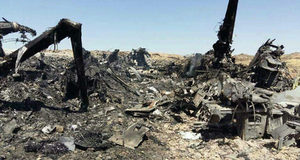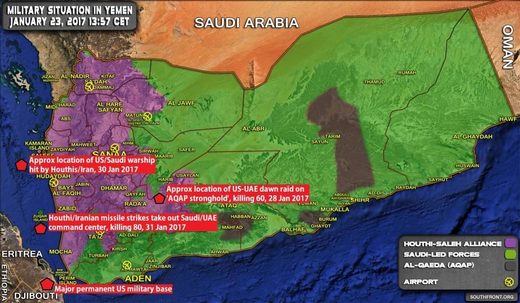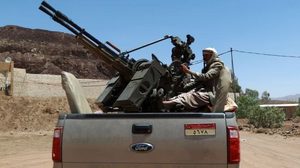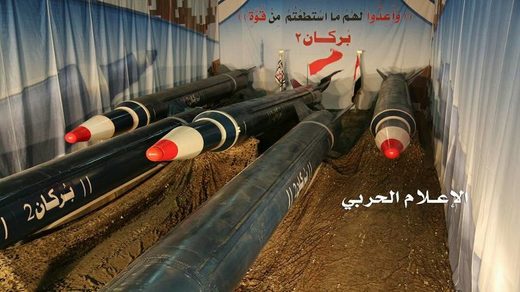
© kokpit.aero
Unconfirmed photograph showing wreckage of the US MV-22 Osprey tilt-rotor aircraft, which suffered a "hard landing" during a "dawn raid against Al-Qaeda" in al-Bayda, central Yemen, 28th January 2017
US government rhetoric against Iran has lately hit levels not seen since the Bush administration, and a string of events over the last couple of weeks in and around Yemen appears to be the reason for it. US drone strikes and airstrikes against targets in Yemen took place before, during and after Trump's inauguration, but it was the US Special Forces (Navy Seals 6) raid in central Yemen on January 28
th that got the US media's attention.
Two days after Trump's inauguration, US drones "
killed five Al-Qaeda operatives" in central Yemen. This operation took place without Trump's knowledge (and thus without his approval)
because his predecessor freed the Pentagon from executive oversight when it comes to drone warfare. The US war machine is, in a sense, sentient.
It generally operates without any official leadership, decision-making or input from 'the civilian government'. The same goes for the multiple drone strikes conducted in 'ISIS-occupied' Syria and Iraq over the course of Trump's inauguration and first days in office.
So while most people might assume that all such operations would cease during the few days between the removal of the old administration and the institution of the new, yet that is not what happens, which is pretty clear evidence that US foreign policy operates independently of the White House.
Seals' Dawn Raid in Central Yemen But then came something that apparently
did involve Trump. On Sunday January 29th, US Central Command (CENTCOM) issued an
incredible press release, which stated that "
one US service member was killed and four more injured" during a counter-terror "
raid against al-Qa'ida-in-the-Arabian-Peninsula (AQAP) in Yemen on January 28." The operation, they said, killed an estimated "
14 AQAP members and the capture of information that will likely provide insight into the planning of future terror plots." Oh, and a US MV-22 Osprey tilt-rotor aircraft used in the operation "
experienced a hard landing," so it had to be "
intentionally destroyed in place [
by US Marine jets]."

© Unknown
Killed in raid: Nora al-Aliki, an 8-year-old daughter of Anwar Al-Aliki, a Muslim-American imam who was killed in Yemen by a US drone strike in 2011
This alarming development naturally raised all sorts of questions, the answers to which anonymous US intel officials were only too happy to provide in subsequent 'leaks' to the media. The story at this point is that US Special Forces, in conjunction with 'UAE Special Forces' (which are, by the way, led by a man named Mike Hindmarsh, former head of the Australian SAS), conducted a dawn raid on a village named Yakla, "
a known AQAP stronghold", in al-Bayda province, southwestern Yemen. Their mission was to "
collect as much intelligence on AQAP as possible in order to facilitate future raids and strikes against al-Qaeda down the road."
Local sources
reported that as many as 57 people were killed in the operation, including eight women and eight children. One of those children was apparently the 8-year-old daughter of Anwar al-Aliki, the 'terrorist mastermind radical Islamic cleric' (and US citizen) who was killed in a drone strike in Yemen in 2011 as punishment for 'influencing' (plotting with? 'jihadicalizing'?) 16-year-old son-of-a-rich-Nigerian-British banker Umar Farouk Abdulmutallab, the
infamous 'underwear-bomber'. CENTCOM made sure to highlight this connection in a
follow-up press release, pointing out that besides the bizarre incident on board that 2009 Christmas Day Amsterdam-Detroit flight, "
the Boston Marathon attack and the attack on the Charlie Hebdo
offices in Paris are all the responsibility of AQAP."
CENTCOM also released a video they claimed was "
a small sample of the sort of intelligence information that was obtained at the site," which they described as a "
staging area, propaganda center, and logistics hub for AQAP's terrorist network." This video "
demonstrates the process for making Triacetone Triperoxide, an explosive used in numerous terrorist attacks, including the attempted 'shoebomber' attack in 2001 and the attacks across the London transportation system in 2005." The Pentagon was, however, forced to take the video down when someone
pointed out that their "
important intelligence information" was
widely circulated 10 years ago by Rita Katz's SITE intelligence company, the private US-Israeli intel outfit that has done as much for publicizing jihadists' 'terror plots' as the Syrian Observatory for Human Rights has done for the demonization of Bashar al-Assad.

© Unknown
President Trump travels with his daughter Ivanka to the funeral of Navy Seal William Owen
The village in question,
according to Baraa Shiban of British human rights group Reprieve, was hit by a US drone strike in December 2013, slaughtering a wedding party. The groom, who survived that strike, was killed this time, along with his son and daughter. Nora al-Aliki, daughter of the 'terrorist mastermind' (who may or may not have herself been a US citizen), bled to death two hours after being shot in the neck, according to her grandfather, Nasser al-Awlaki.
He and other survivors say that the village was not an 'AQAP stronghold', but rather hosting a meeting of tribal sheikhs who have actually been fighting
with the Saudi- and US-backed government of Yemen, (which the ruling Houthi-led movement ousted in a coup in January 2015, precipitating the 'Saudi-led intervention' in Yemen to 'restore the legitimate, democratically-elected government' - an irony that is completely lost on the autocratic Gulf monarchs citing this 'just cause'). Grandpa Awlaki said the 'official' government (exiled in Saudi Arabia) has been delivering weapons to him and his relatives via its forces in Aden
to fight against the Houthis.
Note the location of the village in question: it's nowhere near the supposed 'AQAP strongholds' (grey zones). In fact, it's right along the dividing line between 'Houthi rebels' (which is actually an alliance of Houthi tribesmen and those loyal to the country's former president, Ali Saleh) and fighters loyal to Riyadh's favorite, Mansur Hadi (who was once vice-president under Saleh).

© South Front
Not only were these fighters heavily armed, NBC
reported suspicions that someone tipped them off about the raid. The Pentagon says the Seal Team was met with heavy gunfire ("
even the women were shooting at us"), and it's likely the targets were also packing heavy weaponry if we assume that it was
they who gave the US MV-22 Osprey tilt-rotor aircraft a "
hard landing" rather than US Marine jets "
destroying it in place."
While Trump's spokesman characterized the operation as "
successful", anonymous US intel officials laid the blame for why "
almost everything went wrong" at Trump's feet,
telling the media that "
Trump approved his first covert counter-terrorism operation without sufficient intelligence, ground support or adequate backup preparations." As a result, the mission found itself dropping into "
a reinforced al-Qaeda base defended by landmines, snipers, and a larger-than-expected contingent of heavily armed Islamist extremists." To complete the messy tale, they're claiming the mission was planned months ago, considered by the Obama administration, but then put off till after Trump's inauguration "
for operational reasons."

© Naval Special Warfare Command/Capt. Jason Salata
Chief Petty Officer William 'Ryan' Owens, who was killed in the dawn raid in central Yemen, which apparently went completely FUBAR
With the American public abruptly exposed to the reality of 'boots on the ground' in Yemen, Trump - who campaigned, among other things, on the basis of reining in military adventures abroad - was left holding a bloody knife. It reminded me of JFK's handling of the 'Bay of Pigs fiasco' during his first few months in office. The event has come down to us today as Kennedy either not knowing what the CIA was up to, or only discovering the plan at the last minute then blocking air-support needed for the operation's success. However, thanks to research in David Talbot's
Devil's Chessboard, we now have evidence that CIA Director Allen Dulles never intended for the Bay of Pigs operation to be successful. He sabotaged it from the outset because his primary mission was to 'set the intel community against Kennedy', who was, among other transgressions, threatening to upend 'their' foreign policy.
In any event, the Trump administration has 'owned' the mission, although we cannot take this at face value. The Pentagon is seriously asking us to believe that after 8 years of conducting periodic airstrikes, cruise missile strikes and drone strikes against Yemeni civilians and rebels in a hi-tech war in the poorest country in the Middle East - the whole time during which it not once (officially) risked the lives of US troops - it suddenly, one week into his presidency, gave executive oversight and operational planning for an apparently hare-brained mission to 'collect hard-drives' from 'AQAP terrorists' hiding out in a village barely located within Saudi-backed, loyalist-held territory... to President Donald 'Celebrity Apprentice' Trump. I have serious doubts that he was fully briefed on the operation, then "
gave it the green light." Nothing better illustrates the lack of real power held by US presidents - especially in foreign policy - than the seamless (and, in this case, apparently reckless) military actions carried out by the US, NATO and Gulf Monarchies during the transition from Obama to Trump.
Yemeni (Houthi) firepower 
© Unknown
Cannon-mounted pick-ups used by Houthi rebels against the 'Saudi'-led forces: where are they getting these from?
Let's zoom out now and take in some other events taking place in the southern Arabian peninsula lately.
Two days before the US raid, Houthi rebels
shot down a Saudi Apache helicopter near the Red Sea port city of Mokha in the southwest of the country. In December, another Saudi Apache helicopter was shot down by the Houthis, this time
inside Saudi Arabia, in the kingdom's southern province of Najran. In fact,
the Houthis have conducted dozens of cross-border attacks on military targets inside Saudi Arabia, especially since August last year. Most of them involved close-range shelling and fighting for control of border towns and outposts, but
the Houthis have also launched ballistic missiles at Saudi military bases. In just one coordinated assault in early December, the Houthis
simultaneously took out at least 4 Saudi military bases or command centers in the kingdom's south, with ballistic missiles, then followed those up with intense shelling. The Saudi death toll is unknown, but it's clear their forces took a serious hit.
Just two days ago, there were reports that a ballistic missile fired from Yemen successfully targeted a Saudi military base in Mazahimiyah, 60km from Riyadh. AMN News
reported that the missiles used in the attack were
surface-to-surface missiles called 'Borkan-2', a "variant of the Russian Scud missile." There is as yet no statement on this from the Saudis, though locals have reported on social media that they heard explosions. Iran's PressTV yesterday
cited Houthi spokesmen, who confirmed the missile launches and issued photos of them pre-launch:

© Yemeni military (Houthi forces) via AMN News
And this is purportedly
video footage of the missiles being launched Riyadh's way: